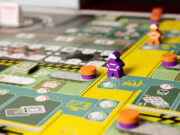 In the early morning, as the sun began to lift over the hills, a dense fog began to dissipate from the battlefield. What we thought were mounds of dirt and debris shifted before our eyes to groupings of bodies felled during combat. Swords littered about. Missing limbs. And throughout the field a trampled ground of muck that covered everything in a dirty gray tinge.
In the early morning, as the sun began to lift over the hills, a dense fog began to dissipate from the battlefield. What we thought were mounds of dirt and debris shifted before our eyes to groupings of bodies felled during combat. Swords littered about. Missing limbs. And throughout the field a trampled ground of muck that covered everything in a dirty gray tinge.
We searched for our father, who we’d followed without permission. We knew the heraldry of his shield, always glimmering in the sunlight, the crescent and lion on a sea of argent and azure. We were unsure if he would be there to greet us, but we’d learned that the family heirloom would always survive.
Blazon, a game of medieval heraldry, was designed by Dave Conklin, illustrated by Ian O’Toole, and published by 25th Century Games. Are you eager to design your own shield using heraldic techniques to ensure your family’s honor lives on for generations?
Gameplay Overview:
Blazon features hand management and tile placement/tableau building and plays from one to four players in less than sixty minutes. It uses a simple turn structure and a restrictive placement space to create a rhythmic gameplay loop. It utilizes a central board to house two distinct element decks (devices and tinctures), five bonus cards (distinctions), and all the main rules via iconography.
The objective of the game is to place element cards onto your player board (a shield) to score prestige, earn distinctions, and have the most prestige upon the trigger of end game. This occurs when any player either reaches fifty prestige points, fills their entire shield, or claims their fifth distinction award.
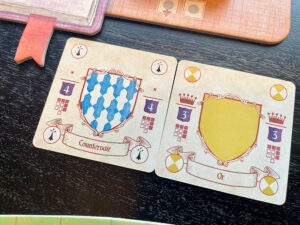
As mentioned earlier, turns are rather simple as you may choose one of two options. First, you can acquire new cards by drawing two from either element deck, then optionally swapping one of the cards in your hand with another of the same type in the market display. Second, players can take the blazon action to place cards onto their shield board. To place a card on a shield, players must also discard a separate card with a prestige of equal or higher value as a cost.
The shield boards contain ten placement spaces for cards and feature specific iconography restrictions at the top and bottom. Device cards feature a square icon and must be placed in a position in a space that matches the card and board icons. This may mean that the card is placed in such a way that it is either aligned to the top or the bottom of the space. Once a card is placed in such a manner, all other cards in that row must be placed in the same alignment.
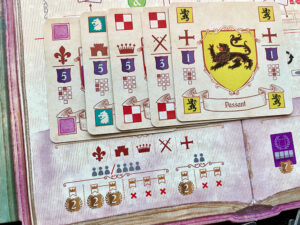
The blazon action becomes a puzzle of how and when to place cards to not only meet alignment requirements, but to also have the proper cards on your shield to obtain distinction awards. Distinctions require specific icons, augmentations (separate icons on cards), or values to achieve them. When a player meets the requirements, they place a cube on the card showing they have completed the goal. The next players to achieve this earn diminishing prestige.
As the game progresses, whenever a player first reaches a prestige of 10/20/30/40/50, they obtain a two-prestige value animal token. All other players are given a herald token. Herald tokens can be used to take bonus actions to refresh the market display, obtain new cards, or place at a discount. And at game end, players score their completed distinctions, majority for each augmentation, as well as receive points if they filled the entirety of their shield board.
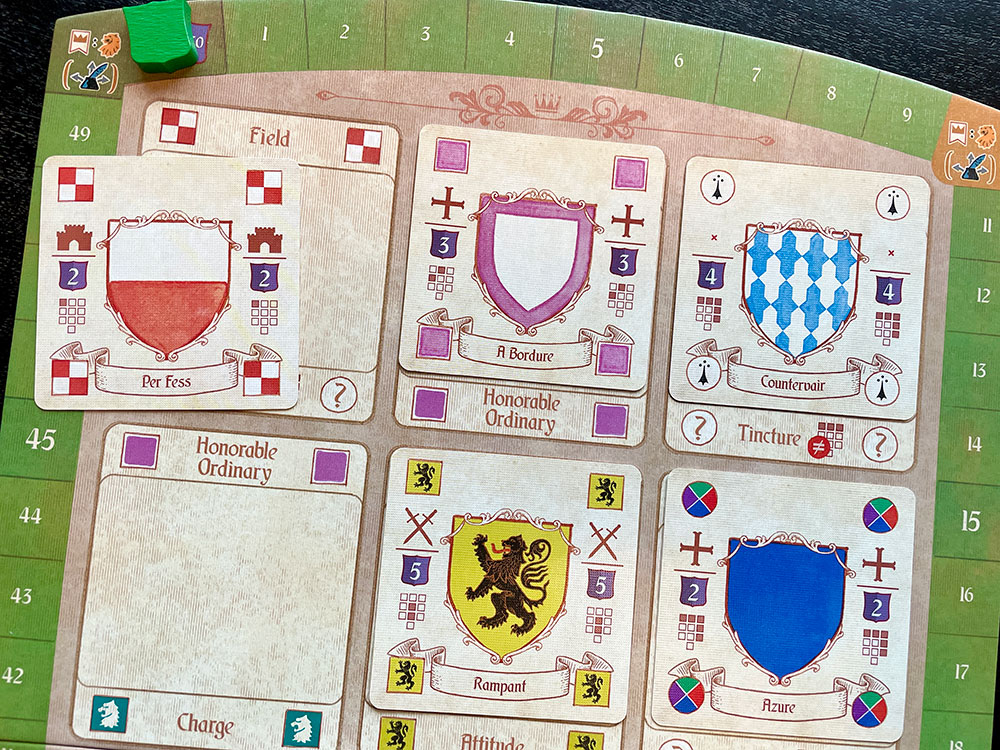
Game Experience:
Over here drinking my coffee, pondering this game, wondering if it works well enough to keep in the collection. I’ve had friends who’ve enjoyed the puzzle, some who’ve not felt challenged enough, and some who downright thought it was a non-event. I fall in the middle of all these thoughts, both having enjoyed moments during play, but also weary of the limited nature of actions. Taking a turn to draw cards, even with the swap option, feels so lackluster.
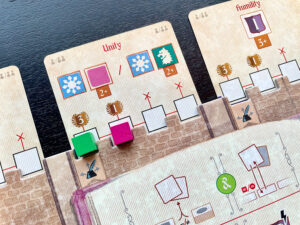
The puzzle of placement is also hit-or-miss on its own but is given a boost by the nature of the distinction awards that become the ultimate motivator during play. Of course, the luck of the draw can dictate a lot with these, as can the nature of the action structure, but it helps having five of these to provide variety. I’m also a fan of how players must constantly be aware of how to pay for their cards, sometimes even having to overpay to get a card in place.
The rulebook does a poor job of showcasing how card overriding works. And in actual gameplay, card placement covers one set of icons, so there’s this fiddly nature of shifting cards to see where things can be placed. It is nice that the actual cards highlight where they can be played on your shield, but I’ve always referred to my shield first. The override rule was the hardest for me to grasp, as placing a new card on top of an old card and then shifting alignment meant that the old alignment was broken, and the cards would shift together. May be a small thing for others, but it didn’t feel intuitive during the first couple of plays.
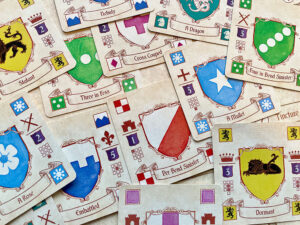
I’m not a big fan of the shield boards and the personal score tracks. Creating individual tracks pulls away from the central race element to reach each new ten-point milestone. That said, I do enjoy the milestone balance where one player receives points, and the others receive bonus actions. It’s also nice that as a game without a round structure, the end game trigger does allow those who did not trigger it to take a final turn, and then beyond that there is additional scoring.
I’m a fan of the augmentation inclusion. The augmentation symbols provide an extra decision space. In fact, without them, I’d be far lower on the game in general. There are five augmentation symbols (and a wild as well) that are necessary to achieve certain distinctions. They also become an area majority scoring bonus at the end of the game. Not being mindful of them has caused a few players at our table to lose their leads.
The game comes with a solo option which proved to be a challenging puzzle on its own, though I don’t think I’ll return to it after a couple plays. There’s also an optional abatement token that allows players to break a placement rule, but also may cause players to lose eight points if not settled and removed later. We prefer to play without the abatement token as the base restrictions were enough to keep us engaged.
Final Thoughts:
Blazon dabbles in a specific time in history and the O’Toole artwork really brings the heraldic designs to life. The inclusion of the syntax on cards was also a nice touch. The game ends up being on the lighter side of play. And it doesn’t really have anything special going for it outside of the unique thematic objective. That said, all our games have been very close and the puzzle mind-bending enough to stimulate during the thirty-to-forty-five-minute playtime.
I do wish there was an additional element or two to pull players in different directions. I also wish there was a way to both draw and play during a turn, though the ten spaces on the shield boards would make this a rather short game. Perhaps that’s why these were separated out to begin with, allowing the market displays to shift and provide new options for players as they worked toward their ultimate armorial design. I’d suggest trying the puzzle out if ever given the chance, though I do not know if it will be found shining above the dirt of the battlefield at the end of the day.
Final Score: 3 stars – The heraldic gameplay shines on occasion but may not survive the passage of time.
 Hits:
Hits:
• Wonderful artwork from O’Toole
• Herald token distribution
• Placement puzzle for distinctions
• Historical notes in rulebook
Misses:
• Simplicity of actions
• Lack of rules clarity on overriding
• Fiddly nature of overriding cards






